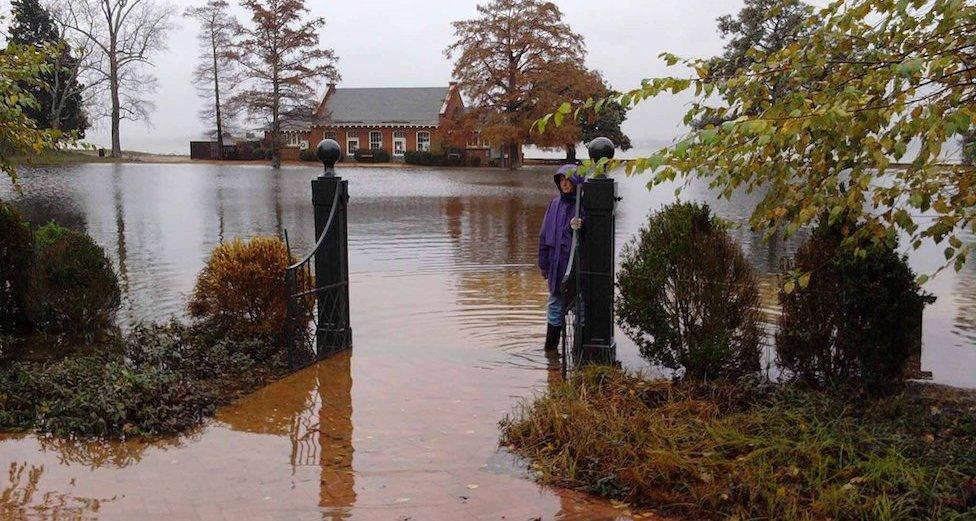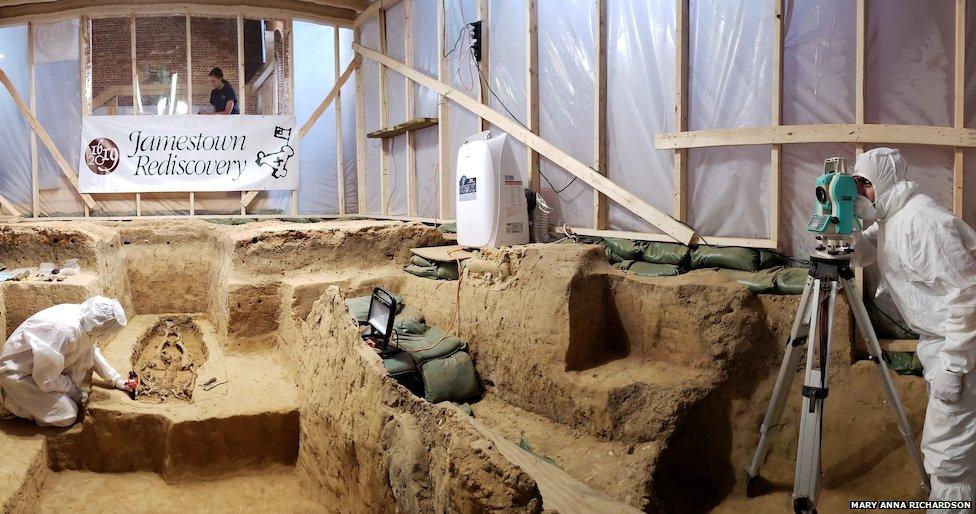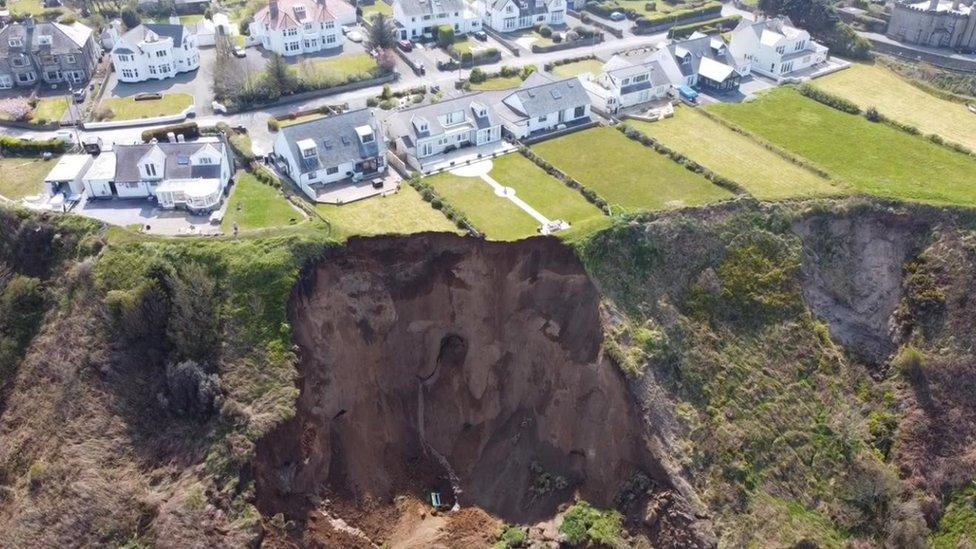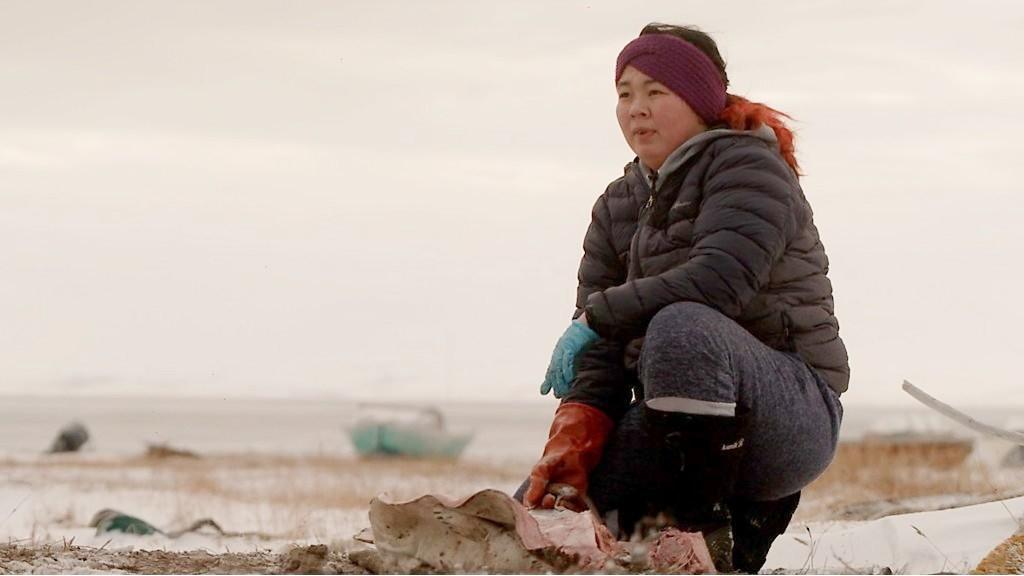Jamestown: America's first English settlement now endangered
- Published

Jamestown Island is threatened by erosion and flooding
One of the most important historic sites in the United States has been put on a list of endangered places. Preservation groups warn that Jamestown, Virginia, may not survive another generation because of climate change.
In 1607, the small island near the mouth of the Chesapeake Bay became the first successful English colony. It is often described as the birthplace of both democracy and slavery in America.
But the tides of the James River are becoming higher and more damaging, the water table is rising, and storms are more frequent and severe, causing dangerous floods.
"There are multiple challenges and they're all related to climate change," says James Horn, president of the Jamestown Rediscovery Foundation. "Essentially, we can't get rid of the water."
The threat from water is nothing new - the James River had already eroded the western part of the island settlement and until digging began in 1994, it was erroneously believed that the original fort was already underwater. Archaeologists have since excavated most of the fort and recovered millions of artefacts. In 2013 they found evidence of cannibalism during the brutal winter of 1609-10, known as the Starving Time. And in 2015 they discovered the skeletal remains of the first settlers.
But climate change is accelerating the pace of erosion and flooding, jeopardising the site as well as further research and the potential for future discoveries.
"Because of the rate of change, we estimate that a good portion of the fort and surrounding area will be underwater within 35 years," says Mr Horn.

Three feet of water accumulated after a storm in 2009. Such events now occur several times a year and the site is often closed for safety reasons
"There is basically a five-year window at Jamestown," says Katherine Malone-France, chief preservation officer at the National Trust for Historic Preservation, which compiles the annual list of 11 Most Endangered Historic Places, external.
"If we do not begin to address these issues within that five-year window, mitigating the impact of climate change becomes exponentially harder. This can't wait another 10 or 15 years. This is about right now."
Work to repair the 100-year-old sea wall is expected to start soon and plans are underway to overhaul the drainage system and install protective berms with pumps. The projects will cost tens of millions of dollars and funding is urgently needed.
Ms Malone-France says Jamestown is particularly important because of its multi-layered - and conflicting - cultural importance.
When the settlers arrived in 1607 they encountered the Powhatan people, launching a complex and often violent relationship with the indigenous tribes. In 1619 the first General Assembly was held - the beginnings of democratic government in America based on the rule of law and individual freedoms. But a few months later slavery was established in the new colony when a ship carrying captives from Angola arrived at its shores.

Archaeologists unearth a grave believed to contain the remains of Sir George Yeardley who presided over the first General Assembly
Jamestown is not the only site on the list endangered by climate change. Olivewood Cemetery in Houston, Texas, is one of the oldest known African American cemeteries. It contains more than 4,000 graves and was incorporated in 1875, 10 years after slavery ended in Texas when federal troops took control of the state at the end of the American Civil War.
Situated on low-lying ground near a bayou, it too is experiencing damaging floods caused by extreme weather and erosion.

America's 11 most endangered historic places
Brown Chapel AME Church, Selma, Alabama
Camp Naco, Naco, Arizona
Chicano/a/x Community Murals of Colorado
The Deborah Chapel, Hartford, Connecticut
Francisco Q. Sanchez Elementary School, Humåtak, Guam
Minidoka National Historic Site, Jerome, Idaho
Picture Cave, Warren County, Missouri
Brooks-Park Home and Studios, East Hampton, New York
Palmer Memorial Institute, Sedalia, North Carolina
Olivewood Cemetery, Houston, Texas
Jamestown, Virginia

Other sites - which include a Japanese internment camp, an artist's house and a cave sacred to native Americans - are threatened by neglect, development and private ownership. And severe termite damage has forced the closure of the Brown Chapel AME Church in Selma, Alabama. The church played a pivotal role in the civil rights marches that led to the Voting Rights Act of 1965.
But Ms Malone-France says climate change is becoming a regular feature of the list. Last year the culturally significant and ecologically sensitive Boston Harbor Islands were included because of the threat of erosion and rising sea levels.
"We have to acknowledge that climate change is an urgent threat to our cultural resources. We have to recognise that and we have to begin to take action," she says. "I have hope because I think these places matter so deeply to people."
She says the work planned at Jamestown could become a model for other historic places threatened by climate change.
Mr Horn says the situation is poignant because the English settlers chose Jamestown because the river offered protection from attack, safe harbour for ships and a vital line of communication.
"What served them well during the early years of settlement has increasingly become the most destructive part of Jamestown," he says. "What they thought would protect them is now leading to the destruction of the site."
Related topics
- Published16 July 2021

- Published9 March 2022

- Published6 November 2021
